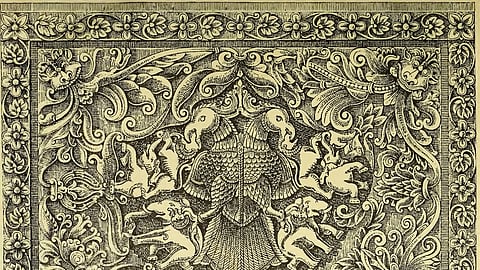- Commentary
- History Vignettes
- Notes on Culture
- Dispatches
- Podcasts
- Indian LanguagesIndian Languages
- Support

THE GOLDEN AGE OF INDIAN EPIGRAPHY was, quite obviously, sculpted by the finest craftsmen and artists. Initially the preserve of Europeans, it was soon populated by an impressive galaxy of top-notch Indian scholars. A partial list of the early European epigraphists of India includes William Jones, Colin Mackenzie, Charles Wilkins, Henry Colebrooke, Walter Elliot, James Princep, Alexander Cunningham, B.L. Rice, James Burgess, Jean Philippe Vogel, G. Buhler, F. Kielhorn, John Faithfull Fleet, Robert Sewell, A.H. Longhurst, Eugen Hultzsch, and John Marshall. The list of Indian epigraphists is more formidable: D.R. Bhandarkar, R. Narasimhacharya, K.N. Dikshit, M.H. Krishna, Hiranand Sastri, Haraprasad Sastri, Krishna Sastri, G.H. Ojha, Daya Ram Sahni, N.G. Majumdar, T.A. Gopinatha Rao, V. Venkayya, R. Sreenivasa Raghava Iyengar, “Mimamsakacharya” Ramanatha Sastriar, J. Ramayya Pantulu, D.C. Sircar, A.S. Altekar, V.V. Mirashi, H.D. Sankalia and R. Shama Sastri.
From an overall perspective, when we study the interpretations, commentaries and explanatory notes on inscriptions written by European epigraphists and scholars and their Indian counterparts, the contrast stands out sharply. This contrast is fundamentally rooted in temperament, attitude and approach. The Europeans studied our archeological artefacts and inscriptions primarily from two perspectives: (1) India as a subject nation and Indians as a people with no sense of history (2) Indian inscriptions as museum pieces. We can cite two representative samples that illustrate this attitude.
The first is by the aforementioned John Faithfull Fleet:
The second by John Dowson, is even more hideous and brazen:
The historians of [India] have been noticed down to a period when new actors appear upon the stage; when a more stirring and eventful era of India's History commences; and when the full light of European truth and discernment begins to shed its beams upon the obscurity of the past, and to relieve us from the necessity of appealing to the Native Chroniclers of the time, who are, for the most, dull, prejudiced, ignorant, and superficial… there is no Native Indian Historian; and few have even approached to so high a standard…of philosophy…we search in vain for any sign or symptom…[The history that we write of India] will make our native subjects more sensible of the immense advantages accruing to them under the mildness and and equity of our rule.
Both Fleet and Dowson were British and further commentary on their views is superfluous, unnecessary, and beneath contempt.
On the contrary, it is a wholesome treat and a sheer delight to read Indian epigraphists and scholars. Their approach towards and treatment of our inscriptions clearly reflects the following main features:
1. A profound sense of cultural yearning, devotion and attachment.
2. Justified pride in the accomplishments of their ancestors who had recorded their deeds.
3. An enveloped sense of unbroken and living connection with their past. To state it explicitly, Indian epigraphists did not study our inscriptions as museum artefacts, or for example, as pyramids which are the remnants of an extinct civilisation and culture.
4. An unswerving commitment to the historical truths revealed by inscriptions.
5. A conscious effort to preserve and disseminate the best elements of our cultural and civilisational heritage revealed by these inscriptions.
To cite just two examples, it is rare to see Indian epigraphists of that pioneering era referring to Ganesha as an “elephant-headed God” or to refer to Krishna as the “dark-skinned cowherd believed to be the eighth incarnation of Vishnu.” Likewise, their commentaries, etc., on our inscriptions display a fine blend of cultural rootedness and academic rigour.
They also wrote truthful and fearless rebuttals to biased, mischievous or erroneous interpretations made by their European counterparts. In the final assessment, most European interpretations of our inscriptions suffer from a fundamental flaw: notwithstanding their high degree of knowledge and scholarship of our languages, etc., they could simply not grasp the cultural nuances that cannot be taught but can only be acquired by living in that environment. Thus, the ubiquitous verse, “Namastuṅga śiraścumbi candracāmara cāravē...” occurring at the beginning of every inscription is simply described as an invocatory verse composed by Bāṇabhaṭṭa and occasionally praising its poetic merit. This kind of “interpretation” thoroughly robs the deep significance that the verse automatically evokes within the emotional and devotional universe of a Hindu. Indian epigraphists and scholars show us the precise contrarian picture.
To be continued
The Dharma Dispatch is now available on Telegram! For original and insightful narratives on Indian Culture and History, subscribe to us on Telegram.
